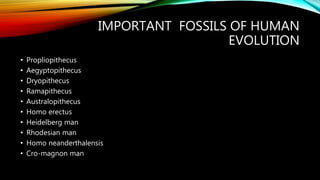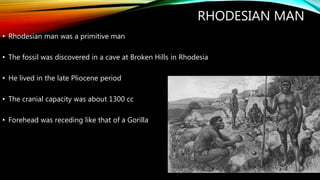Fossil record of human evolution
- 1. FOSSIL RECORDS OF HUMAN EVOLUTION Dr. Ezhilarasi Assistant Professor Department of Zoology, Govt. Arts College, Coimbatore - 18
- 2. IMPORTANT FOSSILS OF HUMAN EVOLUTION ŌĆó Propliopithecus ŌĆó Aegyptopithecus ŌĆó Dryopithecus ŌĆó Ramapithecus ŌĆó Australopithecus ŌĆó Homo erectus ŌĆó Heidelberg man ŌĆó Rhodesian man ŌĆó Homo neanderthalensis ŌĆó Cro-magnon man
- 3. PROPLIOPITHECUS ŌĆó It was an ape-like primate ŌĆó But has short arms ŌĆó It resembled man ŌĆó It lived in the oligocene period (30 million years ago) ŌĆó Fossils of these animals were obtained from Fayum deposits of Egipt ŌĆó Simpson suggests that propliopithecus might be the ancestor of modern apes (Gorilla and chimpanzee) and man
- 4. AEGYPTOPITHECUS ŌĆó It is similar to Propliopithecus but it is more identical to apes than Propliopithecus ŌĆó It lived in upper Oligocene ŌĆó It is believed that Aegyotipithecus was ancestral to the Miocene ape Dryopithecus which in turn gave rise to gorilla, chimpanzee and man
- 5. DRYOPITHECUS ŌĆó It was discovered by L.S.B.Lakey in 1930 on an island in Lake Victoria. ŌĆó He named it Proconsul, but now it is called Dryopithecus ŌĆó It is a group of apes that lived in Miocene period about 20 million year ago ŌĆó It descended from Aegyotopithecus of propliopithecus. ŌĆó Several species of Drypithecus are available ŌĆó Nut more knowledge is gained from an African fossil, D. africanus ŌĆó Dryopithecus has fore limbs shorter than hind limbs ŌĆó In this respect it recembles man. So it is believed that Dryopithecus is the distant ancestor of man. ŌĆó It is also the ancestor of modern apes like chimpanzee and gorilla
- 6. RAMAPITHECUS ŌĆó It was an ape man it lived during late Miocene and early Pliocene ŌĆó It was cntemporary to Oreopithecus ŌĆó The fossil of this animal contains only jaws and dentition ŌĆó The dentition is more identical to man it was directly ancestral to man ŌĆó It was directly ancestral to man ŌĆó Ramapithecus is collected from India and Africa ŌĆó It lived 12 to 14 million years ago
- 7. AUSTRALOPITHECUS ŌĆó It was discovered by Dart. It was an ape-man because it combined many characters of ape and man ŌĆó It may be considered as the connecting link between ape and man ŌĆó It is 2 to 5 million years old.
- 8. AUSTRALOPITHECUS ŌĆó Erect posture with four feet height ŌĆó Bipedal locomotion ŌĆó Vertebral columb has a distinct lumbar curve ŌĆó Basin-like pelvic girdle ŌĆó Forward positin of foramen magnum ŌĆó Dentition is like that of man ŌĆó Dental arch is smooth rounded ŌĆó No simian gap ŌĆó Hands were used for non locomotary function
- 9. APE CHARACTER ŌĆó Small cranial case and brain ŌĆó The teeth were larger than those of modern man ŌĆó No chin ŌĆó The eye-brow ridges projected over the eyes ŌĆó Austalopithecus africanus was a common fossil
- 10. HOMO ERECTUS ŌĆó Homo erectus was the true man ŌĆó He was a primitive man ŌĆó He was a connecting link between ape-man and modern man ŌĆó He lived 5 million years ago ŌĆó Homo erectus lived in Java and Pecking ŌĆó It was discovered by Dubois ŌĆó The home erectus had the following ŌĆó They had upright bipedal locomotion ŌĆó They were slightly taller than Australopithecus and were about 5 feet
- 11. ŌĆó The cranial capacity was about 1300 cc. it was intermediate between Australopicus and modern man ŌĆó Their skull was flattened ŌĆó They had no forehead ŌĆó Their eye-brow ridges projected forwads ŌĆó They used fire and a variety of tools ŌĆó They were cannibalistic ŌĆó They inhabite caves ŌĆó They were hunters and gatherers ŌĆó They had less body hair and were black
- 12. HEIDELBERG MAN ŌĆó Heidelberg man was primitive man ŌĆó His fossil was discovered in a river bed near Heidelberg in Germany ŌĆó He lived 5 million years ago ŌĆó He was an ancestor to Neanderthal man
- 13. RHODESIAN MAN ŌĆó Rhodesian man was a primitive man ŌĆó The fossil was discovered in a cave at Broken Hills in Rhodesia ŌĆó He lived in the late Pliocene period ŌĆó The cranial capacity was about 1300 cc ŌĆó Forehead was receding like that of a Gorilla
- 14. HOMO NEANDERTHALENSIS ŌĆó Neanderthal man was an advanced primitive man ŌĆó The fossil was collected from Neander valley in Germany and hence the name ŌĆó They were slightly shorter than modern men, women were shorter ŌĆó Their eye-brow ridges were heavy and protruding ŌĆó Their forehead was low and slanding ŌĆó They had no chin ŌĆó Their teeth were large ŌĆó The burial was done with some sort of ceremony ŌĆó Their cranial capacity was about 1400 cc ŌĆó They develop speech ŌĆó They used utensils and ornaments
- 15. CRO-MAGNON MAN ŌĆó Cro-magnon man was the extinct modern man ŌĆó Homo sapiens means knowing man ŌĆó He originated about 3 million years ago he become extinct 20000 years ago only ŌĆó He lived in the peak of the old stone age ŌĆó His fossil was discovered in France, Italy, Poland and Czechoslovakia ŌĆó The cranial capacity was 1800 cc ŌĆó He was 180 cm tall ŌĆó Chin developed
- 16. CRO-MAGNON MAN ŌĆó He lived in caves with families ŌĆó He was expert in making weapons and tools ŌĆó He was a hunter ŌĆó He used fire and clothing ŌĆó He buried dead bodies with religious ceremonies ŌĆó He was an arties ŌĆó He reared dogs only
- 17. Thank you
















